Photo Evidence of Police Brutality in Rio de Janeiro Protests
This post is part of our special coverage page Brazil's Vinegar Revolt.
A week ago today, on the evening of June 20, 2013, Brazil was shaken by the biggest wave of protests in the country's recent history. In Rio de Janeiro, an event that began with a peaceful march from the downtown city to the mayor's office spread to other neighborhoods and ended in violent clashes between police and protesters [pt].
According to official estimates, about 300,000 people attended the rally in Rio de Janeiro. Among them, Brazilian photographer Calé recorded in photos the indiscriminate use of rubber bullets, pepper spray and tear gas by the military police on unarmed protesters.
The result are the testimony and photos below, handpicked by Calé for Global Voices Online:
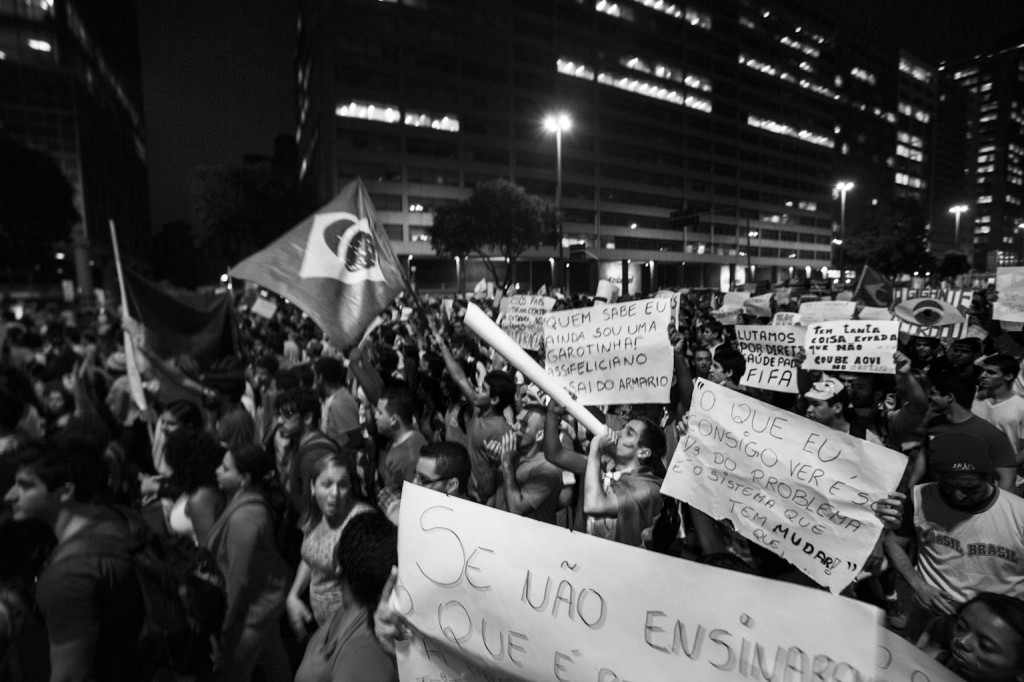
At the beginning of the demonstration, people were dancing and partying on the way to the mayor's office, making it a joyful moment. Photo: Calé, published with permission
Last night I covered the protest in Rio, and saw the police use tear gas and rubber bullets to sweep clean the streets of downtown Rio, in a clear case of abuse of power.
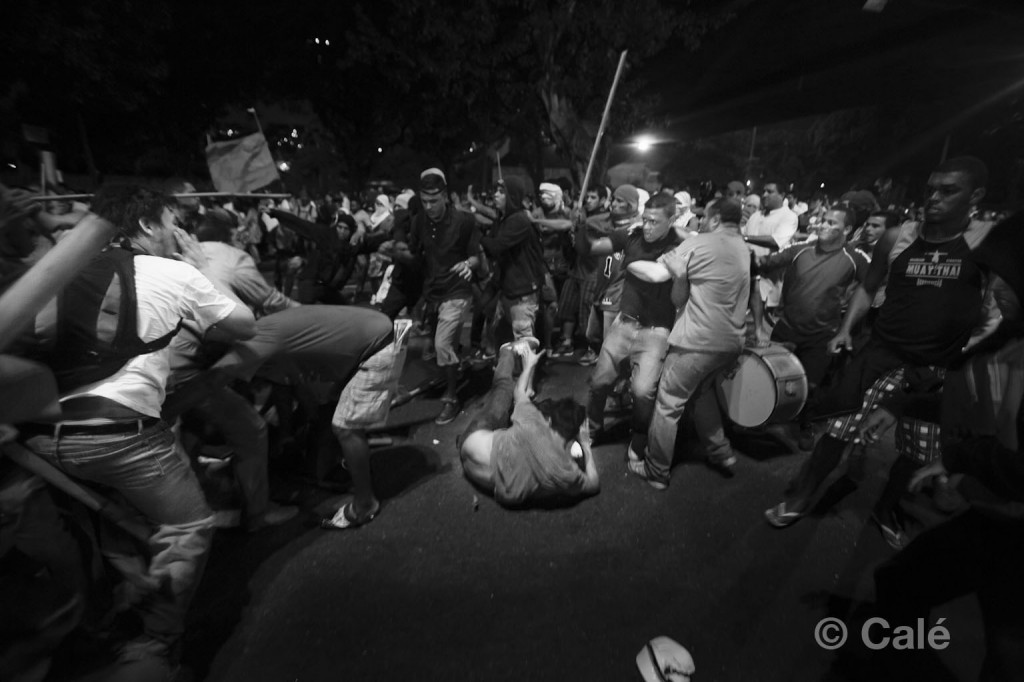
A violent group started a fight with supporters of a left wing party, but police took a long time to respond and didn't arrest anyone. Photo: Calé, published with permission
For the most part it was a peaceful and joyful gathering, with bands playing carnival songs and people of all ages caring flags and posters laying their claims. There were minor incidents, like a fight between supporters of a left wing party and youngsters who disagreed the march should be exploited or connected to any political party.

A man is wounded in the protest and helped by others in the crowd. Photo: Calé, published with permission.
Curiously, the police took a long time to react and only sent 3 motorcycles to check it out, and probably report back. No arrests were made, even though some people were bleeding and pointing out the perpetrators of the attack.
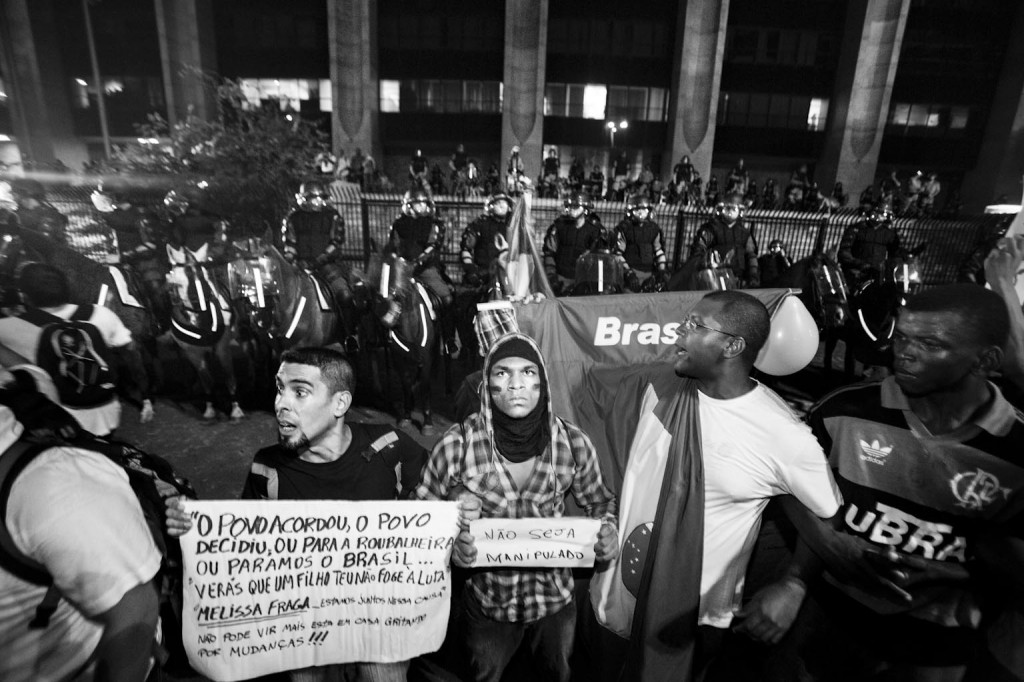
Demonstrators made a human chain in front of the police to avoid skirmishes, and try to keep the protest peaceful. Photo: Calé, published with permission.
When the crowd finally made it to the square in front of the mayor’s office, there was a heavy concentration of officers protecting the building, with the cavalry standing in front the gate. Leaders of the demonstration made a human chain in front of the police to avoid skirmishes, to make sure a small group of bullies wouldn’t spoil such a nice evening.
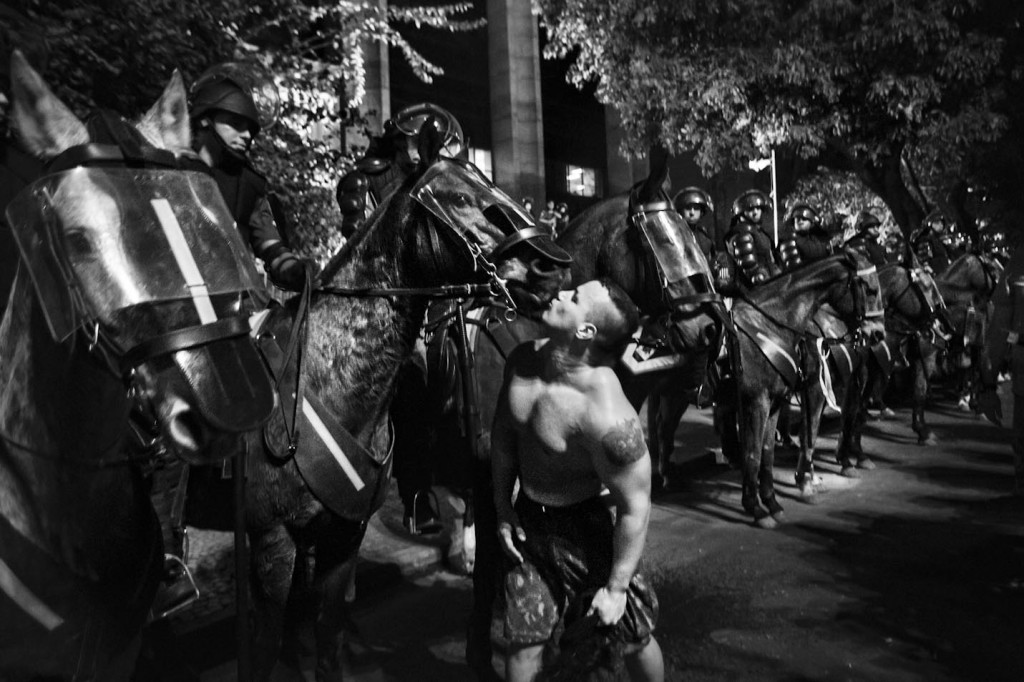
The bodybuilder Gabriel Campos kissing the horse of an officer, as part of his provocations. Photo: Calé, published with permission.
The demonstrators were able to keep it peaceful in front of the mayor's office, until a 29 year old bodybuilder named Gabriel Campos, who is now wanted by the police, started to insult the officers on top of their horses, despite people asking him to get out of there. At one point, demonstrators asked officers to arrest him before it was too late.
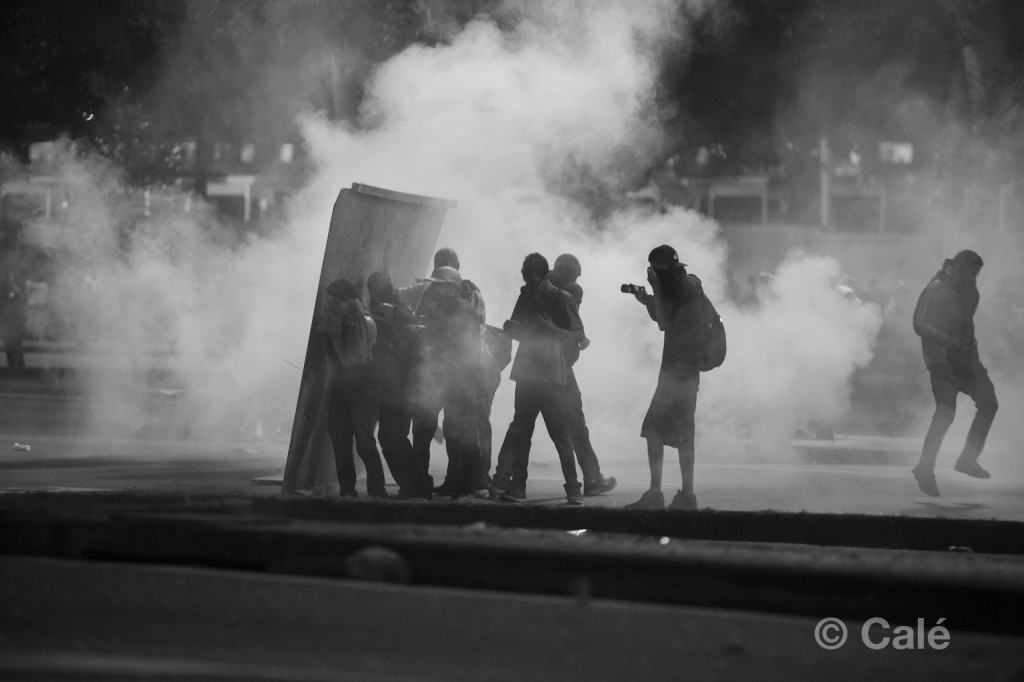
Demonstrators used wood panels as shields and threw stones at the police. Photo: Calé, published with permission
As there was no response, the demonstrators tried to take justice in their own hands, and a fight broke out. It was just the excuse the police was waiting for. At the first sight of misbehavior they started aiming tear gas and rubber bullets at the crowd.

Terror as people flees the Police. Photo: Calé, published with permission.
At no point was there an attempt to invade the mayor's office, the people simply became furious and started to fight back at the police with sticks and stones. What happened next was the biggest case of police abuse of the decade: special troops including Choque and Bope swept the streets of downtown Rio clean, all the way to the bohemian neighborhood of Lapa, 2,5 km away. In response, many stores and buildings were vandalized and robbed on Presidente Vargas Avenue.

Police pass by garbage on fire, as buildings were vandalized on Presidente Vargas Avenue. Photo: Calé, published with permission
Even after the riot was over they kept throwing tear gas at peaceful demonstrators on their way home, far away from the mayor's office. There was no distinction between troublemakers and peaceful people trying to find their way back home. As the subway stations were closed, everyone had to walk their way out of the conflict zone.

A street seller gasps for air after inhaling tear gas, as police become indiscriminate in their attacks, aiming rubber bullets and tear gas at innocent people too. Photo: Calé, published with permission
As the subway stations were closed, everyone had to walk their way out of this conflict zone. At Carioca station a group were waiting for the gates to open, when the police marched by Avenida Rio Branco. This station is located in a pedestrian corridor, perpendicular to the avenue, and when the police was almost out of sight someone shouted “Cowards, son of a b…”, and they immediately turned back and threw gas at the crowd.
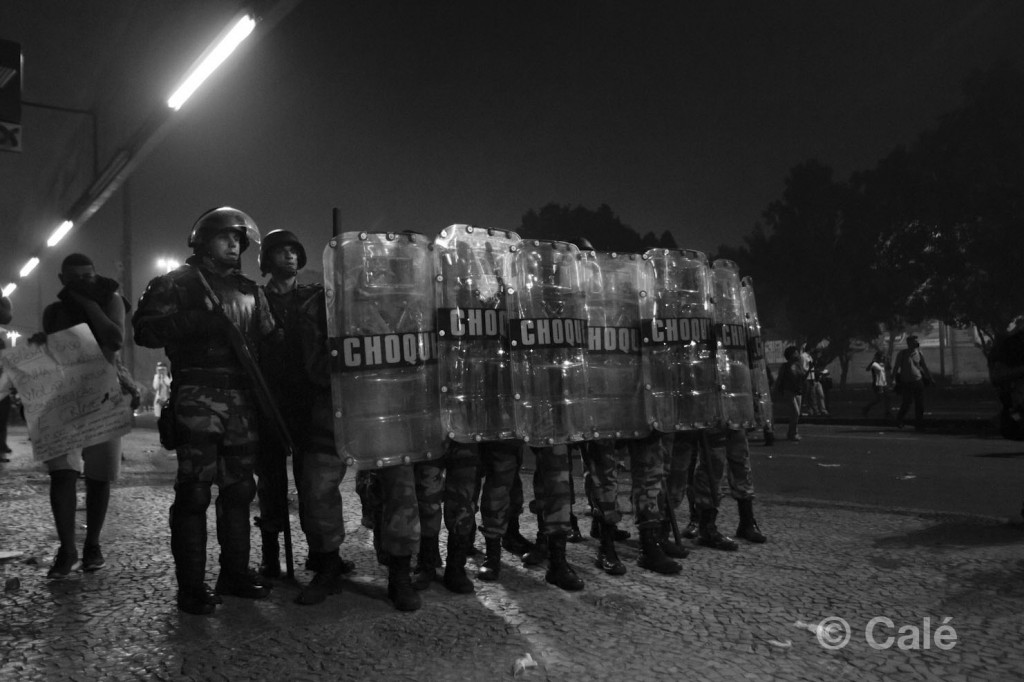
At Avenida Rio Branco, the Choque troop sweep the streets clean. Photo: Calé, published with permission
Quickly the subway crew opened a small gate for people to get in, but ended up creating a trap were people got stuck in a funnel breathing gas. Downstairs many were nauseous and laying down.

People at Carioca station watching police pass Avenida Rio Branco raise their hands in gesture of peace. Photo: Calé, published with permission
Many people who left the march at the fist sign of trouble decided to go to the Lapa neighborhood to have a beer, a distant and safe place in their heads. But soon the squads were there too and they were trapped inside restaurants and bars as chaos reigned in the streets. As people started shouting at the police, they irresponsibly threw tear gas inside buildings too.

Police throws tear gas at peaceful demonstrators waiting for the subway station to open. The subway staff opened a side gate for people to get in looking for shelter, but it created a funnel were they were stuck breathing gas. Downstairs many were laying down nauseous. Photo: Calé, published with permission
Yes, there were vandals in the march who broke and burnt things, but most of these acts were confined to Presidente Vargas Avenue, closer to the mayor's office. So why did the police have such a large ray of action and pointed their guns at innocent people? At gatherings and in social media, people now talk about their fear of joining new demonstrations, and some want it all to stop. Only one expression comes to my mind to explain the behavior of our police force: state terrorism.
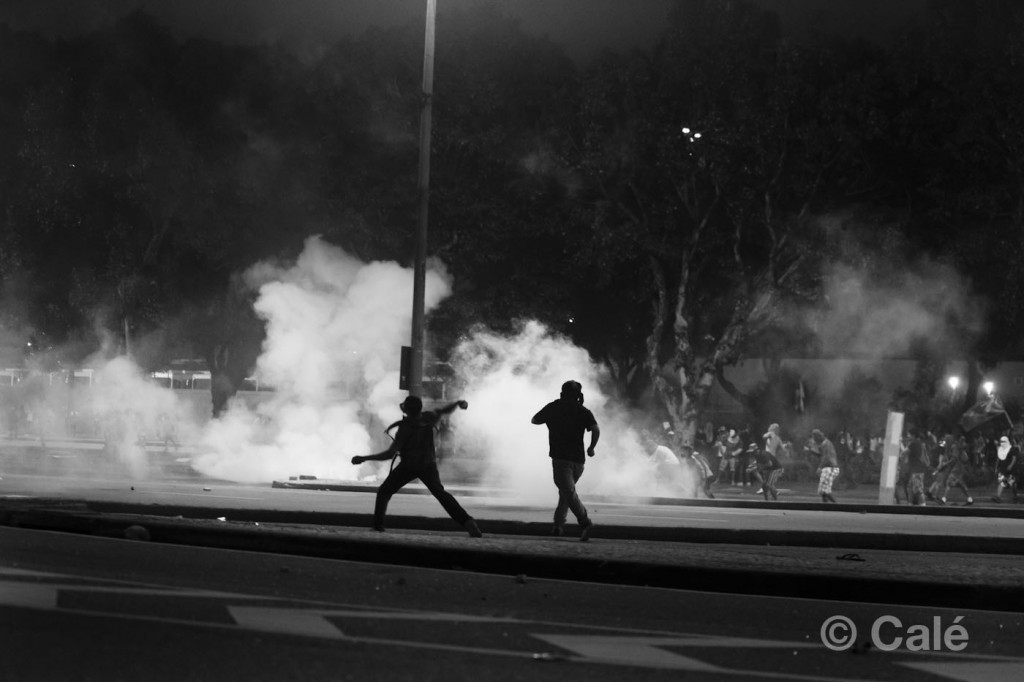
Police pass by garbage on fire, as some started to vandalize buildings on Presidente Vargas Avenue. Photo: Calé, published with permission
All photos in this post have been published with permission from Calé, who besides working as a commercial photographer, has developed artistic and authorial projects all over the world. Some of his photos can be see at the series Buscadores (Seekers), on display at Ateliê da Imagem [br] in Rio de Janeiro. Seekers has been shown in solo exhibitions in Denmark, Russia, Argentina and Bolivia, and has been part of collective shows in USA and Irland.
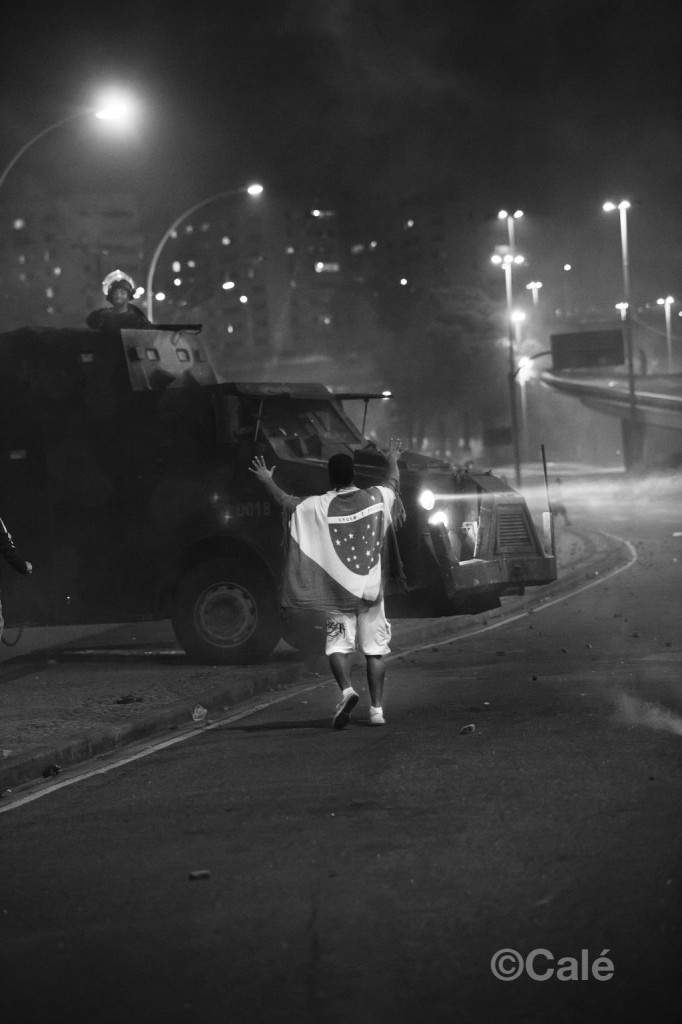
Demonstrator ask for peace in the the middle of the fight. Photo: Calé, published with permission
This post is part of our special coverage page Brazil's Vinegar Revolt.
via Global Voices » Feature http://globalvoicesonline.org/2013/06/27/photo-evidence-of-police-brutality-in-rio-de-janeiro-protests/
Labels: Global Voices » Feature, IFTTT

0 Comments:
Post a Comment
<< Home